The Serious Business of the Funny Car Engine Wars
Drag racing’s first Funny Cars weren’t called “Funny Cars.” They were factory experimental (FX) cars—stripped down two-door coupes fitted with lightweight parts and big engines. In 1964, give or take a year, these special hot rods were given to the favored race teams of a few Detroit manufacturers. Other racers cobbled together their own versions of an FX racer. There were Fords, Mercurys, Chevys, Pontiacs, Dodges, and Plymouths of the most recent vintage. The racers who campaigned them in match races hopped them up, first with fuel injection and later adding superchargers and, ultimately, nitromethane fuel. Seen as the bad-boy class of drag racing, the most heavily modified FX cars—and the supercharged S/FX cars—weren’t welcome at the events of drag racing’s sanctioning bodies. But they were embraced by track owners who just wanted to offer a show that would put butts in seats. And put butts in seats they did, with loud, rocking radio ads that promised Ford vs. Chevy, Dodge vs. Pontiac, and David vs. Goliath, at speeds Detroit’s passenger cars were never meant to achieve.
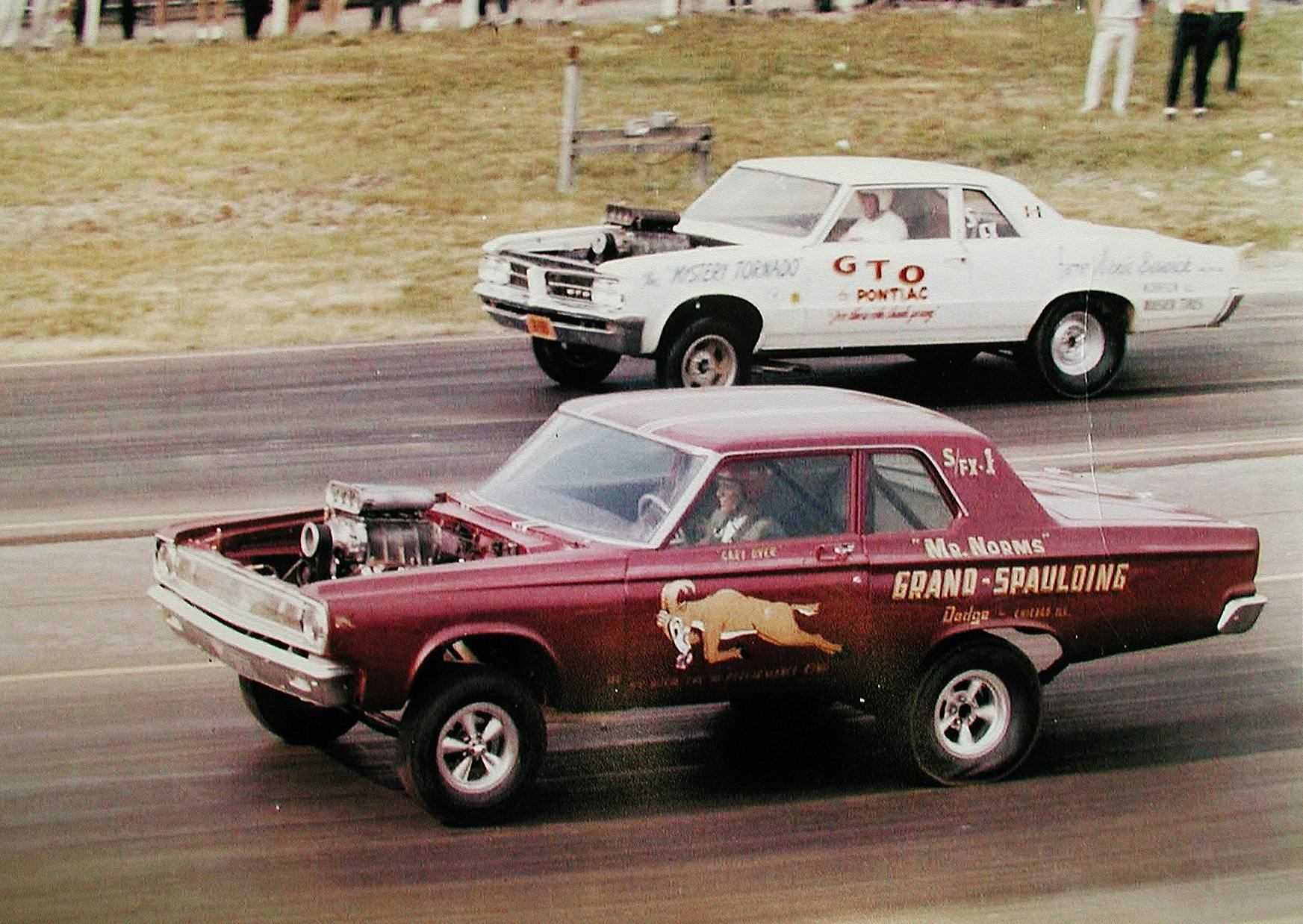
“I’m gonna put that Pontiac-driving farmer right back on his tractor,” screamed a voice on the radio that was supposedly Gary Dyer, driver of Mr. Norm’s Grand Spaulding Dodge S/FX car. And the fans came out in droves to see Arnie Beswick—an Illinois farmer—and his Pontiac take on Dyer and his Dodge.
“Factory experimental” was somewhat of a misnomer in that only a few of the cars on the match race circuit were genuine factory efforts. Among the factory-supported cars, however, were Mercury Comets along with Dodges and Plymouths with Chrysler’s new 426 Hemi V-8 engine. Chevy didn’t officially sponsor cars, but it has been said that trucks left the GM Tech Center in Warren, Michigan, loaded with blocks, crankshafts, and cylinder heads for that maker’s big-block engine, before dropping off said iron at the garages of racers. So too, Pontiac, which covertly supported a few favored racers.
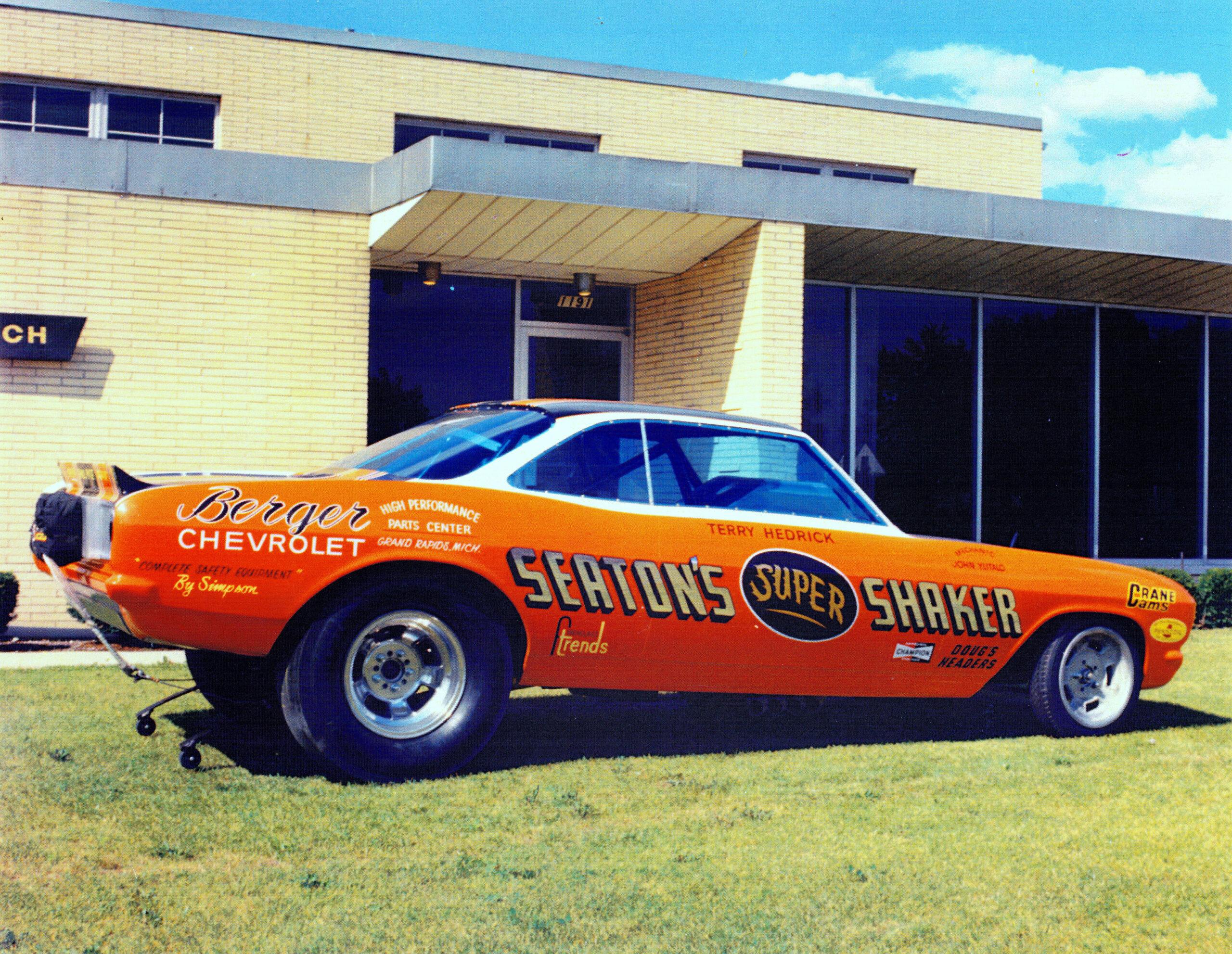
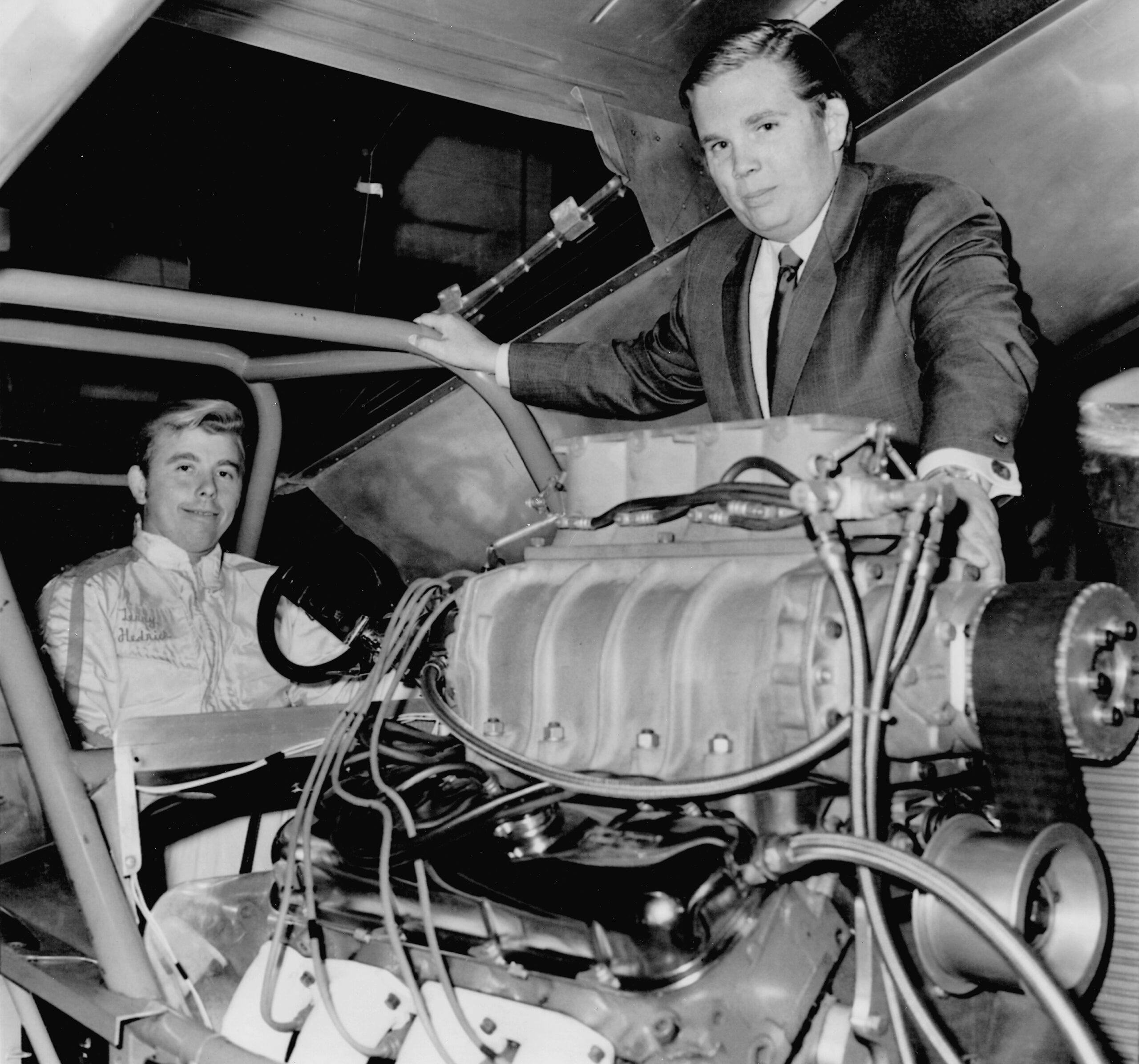

Chrysler Corporation invested in FX racing by producing short-wheelbase, lightweight clones of its street cars for select racers. Because the altered wheelbase made them appear odd, they were disparagingly dubbed “funny cars” by GM and Ford racers. The name eventually stuck.
And it was a battle royale, as no maker wanted to be left in the dust. Dodge took advantage of stock-body drag racing’s popularity early on with a pair of blown and injected cars running on gasoline that raced each other at various tracks in 1964. Ford got serious about FX and provided modified Mercury Comets to numerous racers, including Jack Chrisman, a former top fuel dragster racer. Chrisman was not impressed with the performance of the normally aspirated Comet, and he built a second Comet with a nitro-burning, supercharged engine.
In 1965, Ford upped the ante and installed its newly developed single-overhead-cam (SOHC) V-8 in several Comet FX cars. The engine had originally been developed for NASCAR and was meant to run carbureted on gasoline. When NASCAR banned it, Ford turned to drag racing, giving it to select FX racers and top fuel dragster teams.
At first, the SOHC Ford-powered cars dominated, and Ford performance management responded by asking a local builder of dragsters, Logghe Stamping Company, to build tube chassis underpinnings for its best Mercury Comet race teams. Another maker produced a fiberglass replica of the Comet body, and the first “modern” Funny Car was born. The SOHC Ford engine made good power on moderate loads of nitromethane, and the “flip-top” Comets were kings of the quarter mile. But durability would eventually become a problem.
Ed Pink, who developed Ford SOHC engines for top fuel teams, struggled with the engine. In a 2015 Motor Trend article he said, “This engine was meant to handle maybe 750 horsepower, and we were getting 2500 horsepower out of it. We would be lucky to get four runs for qualifying and four for eliminations from a block. If we did, the crank would be laying in the bottom of a broken-up block.”
By mid ’65, a number of Dodge and Plymouth racers were matching the Ford upgrades piece for piece, bolting on blowers and tipping the nitromethane can. Gary Dyer, who had raced one of the factory Comets in ’64, teamed up with Norm Krause of Chicago’s Grand Spaulding Dodge to build a supercharged Dodge Funny Car on a mildly modified standard-issue two-door sedan body and chassis. At first, he ran high-9-second ETs on gasoline, but midway through the season he switched to nitromethane fuel and was soon equaling the numbers of the Mercury cars.
Toward the end of the ’65 season, Dyer and Norm purchased a lightweight altered-wheelbase car that Chrysler had built for Dodge racer Roger Lindamood. Dyer installed his engine in the Lindamood car, which had been normally aspirated, then he bolstered the unibody chassis, pushed the nitro percentage up a bit, and was soon running eights. At the end of the season, Dyer towed the car out to California for a big Funny Car show at Lions Drag Strip in Long Beach. While most match race teams were stuck in the nines and tens, he put down an 8.653-second, 163-mph pass in the modified steel-body Coronet.
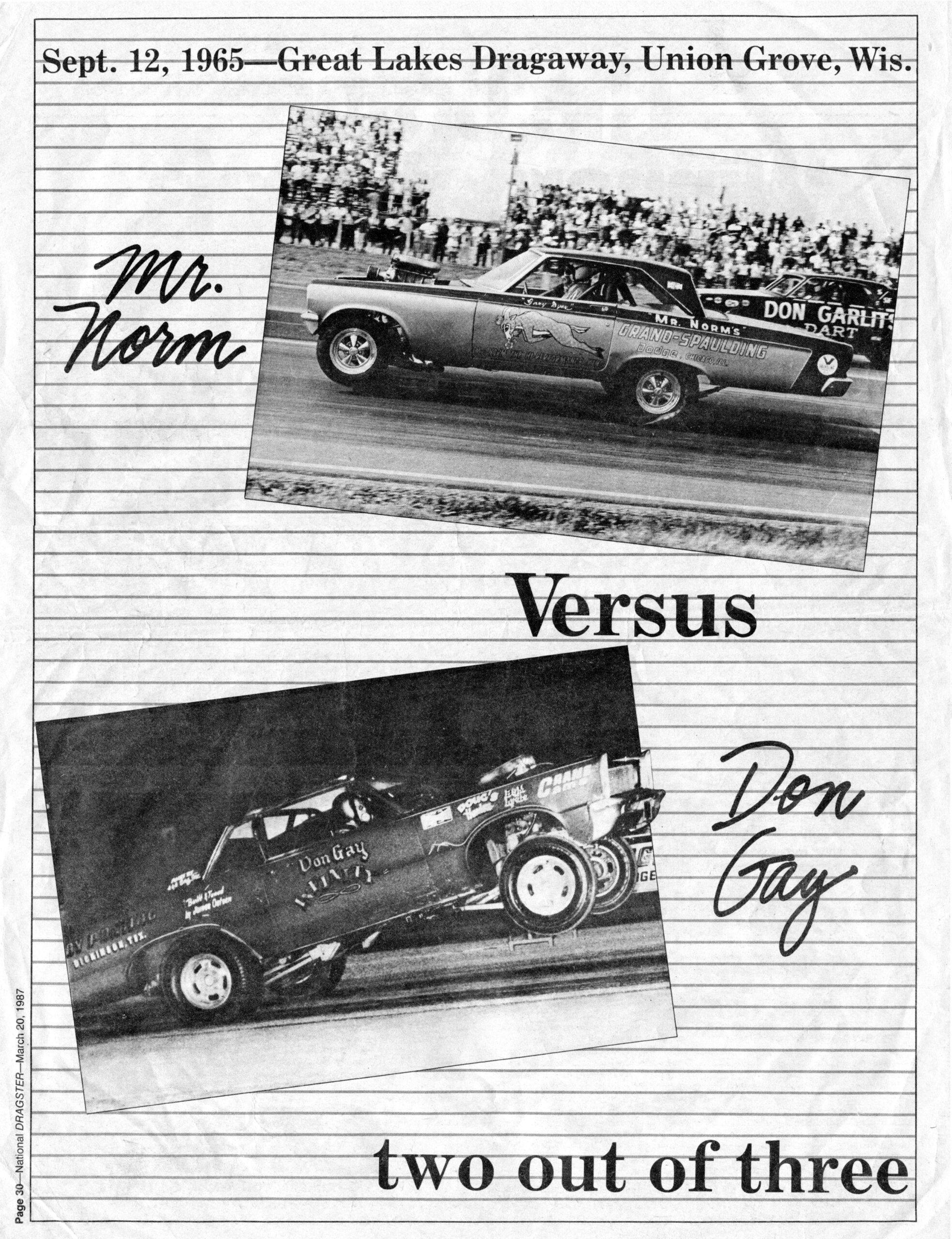
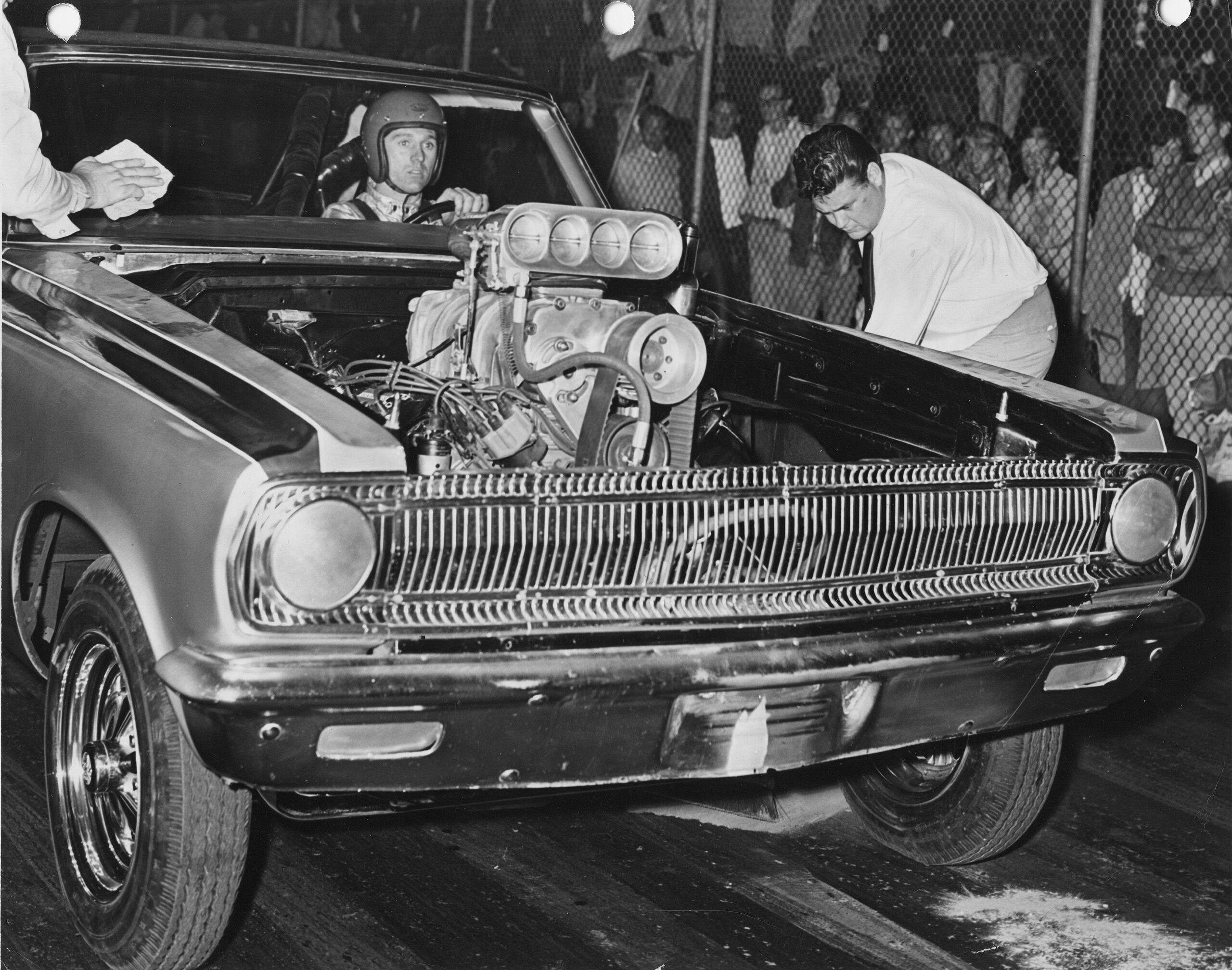

The gauntlet had been thrown down, and to be competitive in Funny Car match racing you had to make big power. Arnie Beswick and his Pontiacs were staying close to Dyer, occasionally beating him in their frequent match-race appearances. Numerous Ford and Chevy racers were running big numbers, too, and a Ford vs. Chevy match race guaranteed a big draw for the track owner and, more often than not, a lot of oil and chunks of aluminum on the dragstrip
As the 1967 season got underway, it became obvious that a modified steel-bodied production car wouldn’t cut it on the match-race circuit. Soon, fiberglass-bodied, tube-chassid Funny cars were sprouting like weeds. By late ’67, the best cars had broken the 8-second quarter-mile barrier, and competition became heated. Mopar racers in their Dodge and Plymouth cars were faring well, making plenty of power with Chrysler’s Hemi. Those with good mechanical skills could do so without a lot of carnage. For example, the “Chi-Town Hustler” team of Farkonas, Coil, and Minick ran the same engine for all of ’67 and ‘68 in their ’67 Barracuda Funny Car, recording mid-7-second ETs, setting track records, and winning consistently on the match race circuit.
“Jungle” Jim Liberman campaigned a ’67 Chevy II with a big-block engine and had to settle for 8-second ETs to avoid expensive engine failures. The Chevy engines were stout enough and were very good powerplants in normally aspirated form, but they didn’t like big loads of nitro and a supercharger. Austin Coil, who is considered one of the best supercharged nitro-fuel engine tuners of all time, explained why.
Like most V-8 engines, he told me, the Chevys have ports that are offset from the valves and curve a bit on their way to the combustion chamber. So when fuel enters the chamber it swirls around the circumference. Fuel mixture swirl is generally an advantage in a normally aspirated engine because it enhances combustion. But in a supercharged nitro-burner, it’s a distinct minus because fuel is forced down to the ring lands as the piston comes up on compression. With lots of cylinder pressure and a high percentage and volume of nitromethane, the resulting violent explosion lifts the ring lands, effectively destroying the piston. Make another run without swapping in a new piston, and the damaged part could escape through the side of the block, igniting a fire as oil hits the exhaust pipes.
As fierce competition led to racers pushing their engines harder, the Chevys destroyed pistons regularly. The same was largely true of Pontiac engines, but they were also plagued with head gasket problems. Pontiacs had only 10 head bolts per bank, while the Mopars had 17, and the big-block Chevies had 14. All builders of supercharged nitro-fuel engines augmented the seal of the head gaskets with copper-wire O-rings in a groove around each cylinder. Because of the bore spacing on the Pontiacs, it was impossible to install separate O-rings for each cylinder. Instead, racers “siamesed” the O-ring grooves between cylinders. Installing the wire perfectly was difficult to say the least, and even when installed correctly that fix wasn’t as effective as two distinct O-rings. So head gasket failures were common on the supercharged fuel-burning Ponchos. A failure usually meant a destroyed engine block as combustion heat and pressure burned away the block deck.

Some racers were able to make Chevy fuelers work well into the 1970s by limiting fuel loads and exercising extreme caution with boost and other tuning variables. Most notable was Dick Bourgeois, who drove and tuned the Doug’s Headers car. Bourgeois was running 6.60-second ETs as late as the mid-70s. But long term, running a Chevy engine supercharged on nitromethane was a losing battle.
Although the Ford SOHC engines weren’t designed to tolerate supercharging and big loads of nitromethane, they ultimately disappeared from lack of support. Ford stopped manufacturing the engine because it couldn’t use it in NASCAR and probably deemed it too expensive to produce for passenger cars, as Chrysler had done with its 426 Hemi. But Ford had another engine waiting in the wings: the Boss 429 “Shotgun” motor.
In 1971, Mickey Thompson, with support from Ford, built a Pinto Funny Car with a titanium chassis and a Ford Boss 429 engine, supercharged and on nitromethane. After running very well at times with Dale Pulde in the driver’s seat but also encountering breakage and numerous fires, the team eventually switched to a Chrysler 426 Hemi. Asked why they gave up on the Ford 429, Pulde said, “The aluminum heads fell apart, the valvetrain was weak. The deck was short, which made for a less-than-ideal connecting rod angle. We built 1-inch spacers and sleeved the engine all the way through the spacers to enable longer connecting rods, but it was a losing battle. There was great parts availability for the Chrysler Hemi, so we eventually made the switch.”
Most other Funny Car racers who were running engines that matched the brand of their car’s GM or Ford fiberglass body eventually gave up on the maker’s powerplant as well. Arnie Beswick, for example, who had gained a large following with his Pontiac-powered GTOs, Firebirds, and Tempests, finally threw in the towel and switched to a Chrysler 426 Hemi in 1972.
If there was competition to become the dominant engine in Funny Car racing, Chrysler won going away. But the 426 Hemi wasn’t bulletproof. When competition and the resulting horsepower race led to more fuel volume, more supercharger boost, and increased displacement, cracked main webbings became a significant problem for the cast-iron Chryslers. High-strength aluminum aftermarket blocks addressed that issue, with Ed Donovan introducing a block based on the 1958 Chrysler 392 Hemi and Keith Black producing a stout aluminum version of the ’64–’71 426 Hemi.
The Keith Black 426 clones proved far more popular than the Donovans, likely because most racers were already running cast-iron versions of the later-model Hemi. By this time, the National Hot Rod Association (NHRA) had welcomed Funny Cars and the crowds they drew into the national event ranks. To standardize specifications for professional Funny Car and Top Fuel racing, NHRA developed engine specifications based on the Chrysler 426 that would dictate the design of aftermarket manufactured engines.
Those specs still define the basic design of the 11,000-plus horsepower fuel motors that thrill fans today. Several companies make cast aluminum or aluminum billet versions of the Hemi drag racing engine, but they’re all made to the same specifications, and the aluminum two-valve cylinder heads atop them are nearly indistinguishable from those used in the late ’60s 426 Chrysler Hemis. If you walk through the pits at a national NHRA event you’ll see Hemi valve covers emblazoned with Dodge, Chevrolet, Ford, and Toyota logos, to match the branding of the race car’s fiberglass body. But deep down inside, they’re all direct descendants of Chrysler’s 426.
***
Check out the Hagerty Media homepage so you don’t miss a single story, or better yet, bookmark it. To get our best stories delivered right to your inbox, subscribe to our newsletters.



Thanks for a well-written and fact-filled story – as well as some great photos! Nostalgia drags are fun, but nothing will ever rival this era lived in real time. To a performance geek, the ’60s-’70s brought nirvana to dragstrips, circle tracks, road courses, off-road and rally racing – but nothing quite had the variety and quick-evolution of the 1/4-mile match race circuit.
I was a light-to-light street-racer turned neophyte dragstrip runner in the mid-’60s. When I took my mostly stock cars out on the weekends, I marveled at what was happening with the FX cars and then the Funny Cars. I would say my prayers every night that someone would drop one of these radical quarter-milers into my driveway – but it never happened. But I sure spent a lot of great days and nights watching them blast down the tracks.
Factually, the ‘funny car’ concept goes back before the altered-wheelbase racers; NHRA (and other drag sactioners, I imagine) had a ‘Super Factory-Experiemental’ class as early as 1962. These cars were only vaguely stockers, as everyone knew, but they were the fastest of the top-tier Super Stockers to race, eg. above S/S or S/SA classes.
Mickey Thompson was one of the first, his sponsor Pontiac being very bullish on competition at any level (they even raced Tempests in NASCAR ‘Compact’ classes!) and with their connivance, he and Hayden Proffitt built two ’62 Tempest coupes with SD 421 engines, which won the S/FX class at the Nationals. To do so, they had to take out the vaunted transaxle/IRS setup, and put in big car 9.3-in. r&p rear axles, and rand B-W T-10 four-speeds. These two cars never had ‘circus paint jobs’ but they were fast, dropping almost a half-ton of weight from the big Poncho’s avoirdupois by that simple (laborious) process!
The next year, John DeLorean decreed that PMD would build their own FX cars (plus one for USAC oval racing) and Pontiac Engineering turned out a dozen 421 SD Tempest coupes (PMD never built 2-dr HT’s in the Y-bodied cars, though Buick and Olds did!) that kept the torsion-bar driveshaft, and a crazy twin Powerglide rear transmission that launched using the clutch, and then shifted at full-throttle automatically.
If you want ‘funny’, these cars were very different, even tho built in Pontiac MI! Beswick, Gay, Ursamarsa, a dealership in TX whose name escapes me, and numerous others won with these Wild injuns. Mick implied that he drove his own example also, and never had trouble with the torsion-bar drive shaft!*
So did Paul Goldsmith, driving for Ray Nichels, at the Daytona Challenge Cup ‘250’ in race #50, the one ‘rope-drive’ Tempest set up for roundy-round work. The win was documented in TIME Magazine, which said he was piloting a stock-bodied compact “with the aerodynamics of a 2-by-4” to beat AJ Foyt in a GranSport Corvette, and former World Champ Pedro Rodriguez, in a lil’ Ferrari GTO — no less. By five miles, too! Legend says that this ‘funny car’ was bought by Mercedes-Benz, and has never been seen again, though several SD 421 Tempest replicas are around the country. Sooo… maybe Pontiac has some claim to the “GTO” title? Funny!
*Don’t forget, Mickey built his own 421 ‘hemi’ engine too, and won top fuel in ’63! Ole’ Wick
We have have a local collector who owns the original Tameless Tiger That Arnie Bestwick drove. This is the supercharged altered wheel base one he drove and crashed. It was restored back to original form. These had to be some scary cars to drive. So much power in chassis that people were still trying to figure out.
Don Snyder owns the first Tunderbolt Butch Leal drove and owns a number of other real thunderbolts. But he is most proud of his two Pontiacs. His Bestwick car and his Super Duty Catalina that is by far the best condition one I have ever seen. And I have seen a lot of them.
He has an amazing collection and is kind enough to share it with tours.
Yes, the altered wheelbase cars were a handful to launch. I saw Dick Landry at lions drag strip in Long Beach when he brought his altered wheelbase car out the first time. He nearly lost it when he launched it the first time. By the end of the day, he was starting to get the feel of it.
As much as these were ‘ the good old days ‘ , and in some respects they were, todays Pro-Mod cars have a similar- ‘ So what you running ? How far can you push it ? ‘ – vibe. Super, turbo or nitrous , the mad scientists crouched over their flow benches can choose. Good to see them get ( at least some of ) the coverage they so rightly deserve today.
Great story and photos Paul. We’re yours taken with a Pentax ?
Factory Experimental, not funny car.
Yes, the lesd photo is an A/FX car as the article says.
I still use a Pentax K1. But all the pics in this article are from other sources.
We lived the 60s wars on the streets and drag strips in the Chicago land area. It was intense at times.
Mr Norms Dodge and Nicky Chevrolet were top dealers in the area.
Some friends had very fast and great looking hotrods.
Many match races on the tracks and streets.
Great fun by all.
Paul
Yes indeed, the “funny car” label was as accurate as anything could be when those altered wheelbase machines emerged at the staging lanes. They certainly were entertaining and helped a lot of us street guys get the concepts of weight transfer et al and how we could improve our game in our door slammers.
The SHOC certainly ran some strong quarter miles but my recollection of the evolution of that power plant wes that straight line racing was seen as a secondary use after having had difficulty running full duration in NASCAR events. What was considered the “90 day wonder” had casting issues which led to piston/cylinder issues in race conditions. Of course that is just what I recall having “heard” or read in my youth, and that is way back in history now.
The SOHC never ran in NASCAR. I don’t know anything about the SHOC engine that you speak of.
The person who invented the funny car and had a large impact on Drag Racing is Ron Pelligrini https://ronpellegriniracing.com/Google his name and there is a lot more about him. He is the first person to put a big block in a mustang. He was trying use the mustang with Ford in racing before Carrol Shelby. I will be selling his GMC Motorhome soon that he bought to keep his wife happy at the races.
Paul, well done. Seems to me you might be the right guy to write the book. Tom
I’ve heard the returns on motorsport books are minimal, Not sure I van afford to put in the time required. But I appreciate your suggestion!
We’ve come a long way Baby!
So the answer is MOPAR. Period.
Geese; because GM pulled out of racing? Biggest engineering plant in the world, and not competing, perhaps?
Thanks for a well-done and accurate article. The stories from that time – a buddy of mine was a Chrysler contract driver during the A/FX era – are fascinating and very amusing, but unfortunately most of the participants (drivers) have passed on.
The best article I have read on Hagerty! Extremely informative!
I worked at Detroit Dragway in 59′-60′ and again in 65′ & 66′ and watched several of those SOHC Fords go airborne due to a lack of proper aerodynamics.
The most impressive cars I watched run were, in no particular order.
Jack Chrisman’s 65 Comet – Jack smoked the tires all the way down the track.
Hurst Hemi Under Glass – although not a true Funny Car, it was fun to watch.
Art Arfons Green Monster ran an Allison V12 for power and 4 slicks on the rear for traction it was a hoot to watch.
I met Don Garlits on several occasions usually after the race when we would be sitting around the office and he would stop by to pick up his money. When you looked him in the eye, you knew that this guy was smart and had no fear.
The loudest racer I ever heard, until recently was the “Ramchargers” – “High & Mighty Gasser” it had 8 megaphone exhaust headers and made as much noise as a jet hitting after burner on a flight deck (worked there too).
Tomorrow I am going to the Virginia NHRA Nationals; this year I will be 82 and still love “The Sound and Fury”
Next time I will tell you the story about Roland Leong offering me a ride in the “Hawaiian” at Budd’s Creek.
They were great times!
‘Was 16 in 66 and CKLW was blaring the ”Sunnnndaaay at Detroit Dragway” ads… ” Also My older brother had a subscription for their newsletter… a simple mimeographed sheet listing results and upcoming events. So several of us went to Detroit Dragway to see Mr Norm go against several … One was Chevoom.. a yellow Chevelle sponsored by Gratiot Auto Parts… which also ran ads on CKLW… it blew the engine…. driver was OK… Norm won the night….
I loved those radio ads!
This was as much a great story about the history of a class as it was a love letter to the 426.
Chicago area legends! Amazing the speeds they got before I was born!